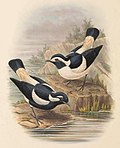| Grallina | |
|---|---|
 | |
| Male magpie-lark (Grallina cyanoleuca) | |
| Scientific classification | |
| Kingdom: | Animalia |
| Phylum: | Chordata |
| Class: | Aves |
| Order: | Passeriformes |
| Family: | Monarchidae |
| Genus: | Grallina Vieillot, 1816 |
| Type species | |
| Grallina melanoleuca [1] Vieillot, 1816 | |
| Species | |
See text | |
| Synonyms | |
| |
Grallina is a genus of passerine bird native to Australia and New Guinea. It is a member of a group of birds termed monarch flycatchers.









